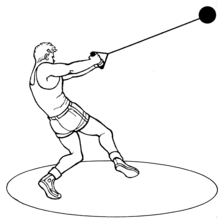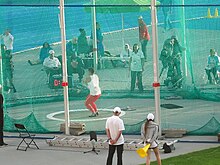Portal:Sport of athletics/Selected article/26

The hammer throw is one of the four throwing events in regular outdoor track and field competitions, along with the discus throw, shot put and javelin.
The hammer used in this sport is not like any of the tools also called by that name. It consists of a metal ball attached by a steel wire to a grip. These three components are each separate and can move independently. Both the size and weight of the ball vary between men's and women's events. The women's hammer weighs 4 kilograms (8.8 lb) for college and professional meets while the men's hammer weighs 7.26 kilograms (16.0 lb). (Full article...)
The men's hammer weighs 7.26 kilograms (16.0 lb) and the women's weighs 4 kg (8.8 lb), with the wire in either case no more than 122 centimetres (48 in) in length.[1] Like the other throwing events, the competition is decided by who can throw the implement the farthest.
The throwing motion starts with the thrower swinging the hammer back-and-forth about two times to generate momentum. The thrower then makes three, four or (rarely) five full rotations using a complex heel-toe foot movement, spinning the hammer in a circular path and increasing its angular velocity with each rotation. Rather than spinning the hammer horizontally, it is instead spun in a plane that angles up towards the direction in which it will be launched. The thrower releases the hammer as its velocity is upward and toward the target.[2]

Throws are made from a throwing circle. The thrower is not allowed to step outside the throwing circle before the hammer has landed and may only enter and exit from the rear of the throwing circle. The hammer must land within a 34.92º throwing sector that is centered on the throwing circle. The sector angle was chosen because it provides a sector whose bounds are easy to measure and lay out on a field (10 metres out from the center of the ring, 6 metres across).[3][4] A violation of the rules results in a foul and the throw not being counted.[citation needed]
| More selected articles |
- ^ "Hammer Throw". World Athletics. Archived from the original on November 19, 2021. Retrieved May 12, 2022.
- ^ Johannsen, Dana (1 August 2021). "Tokyo 2020: Why the Olympic hammer throw may become a new national obsession". Stuff. Retrieved 1 August 2021.
- ^ "Hammer Throw". World Athletics.
- ^ "Laying Out Sector Angles for the Track and Field Throwing Events" (PDF). USA Track & Field Pacific Northwest. Archived (PDF) from the original on 2015-05-13. Retrieved 2022-03-19.
The shot, discus, hammer & weight throw sector is 34.92º. This angle was chosen due to its simple geometry.
